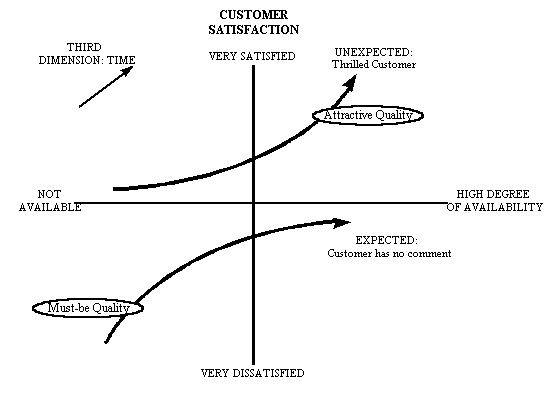In 1984 the Japanese quality guru, Professor Noriaki Kano, introduced a two-factor quality model, commonly known as "Kano's Curve" (Figure 3.2). The curve illustrates the difference between must-be, attractive, and linear quality elements. The horizontal axis describes customer satisfaction that can move from "very dissatisfied" to "very satisfied". The vertical axis describes the existence or non-existence of a quality element, ranging from "not available" to "high degree of availability".

Must-Be Quality is an attribute which the customer expects as a matter of course. If it is not there, the customer will be extremely dissatisfied. This minimum acceptable standard is effectively a qualifier, very like Juran's "fitness for use" concept or Maslow’s "hygiene factors". For example, customers expect a prompt response when calling a call centre, if the call centre takes a long time to answer the call the customer will be extremely dissatisfied. However, if the call is answered promptly, the customer will not express satisfaction but treats it as a normal, standard occurrence. The consequence of this is that "must-be" attributes invariably face a diminishing rate of return. Beyond a certain point, improvements in "must-be" qualities will yield no discernible improvements in satisfaction.
Attractive Quality is that aspect of a product or service that goes beyond established current needs and therefore is not expected by customers. In contrast to the "must-be" qualifiers these aspects genuinely can differentiate a particular service. If a new feature gives customers a benefit they seek, the customer may be thrilled and excited, but if this feature is not available, the customer has no comment. For example Federal Express identified that customers felt a concern when they sent their parcels that they may not arrive on time, if at all. By providing a Web based service customers can check that their parcel has been delivered and signed for. This "closes the loop" and gives customers a new value element which provides a benefit. While no other player in the business has a corresponding service customers will see this as a differentiating value element. Attractive qualities are not missed if they are not present, but provide a differentiatiator when they are.
Clearly services need to identify the "must-be" qualities and ensure that they provide them. However these will only ever serve to close the gap. By providing attractive qualities which the customer does not expect companies not only go beyond simply closing the gap, they also offer a unique selling proposition which separates them from the competition.
The strength of the Kano model is that it identifies that some aspects of service are simply required to be "in the game" whereas others serve to genuinely provide competitive advantage and that there are diminishing returns to be gained from simply focusing on must-be qualities. However Kano does not provide diagnostic tools to identify or measure the different aspects, nor does he suggest how they change with time or environment.